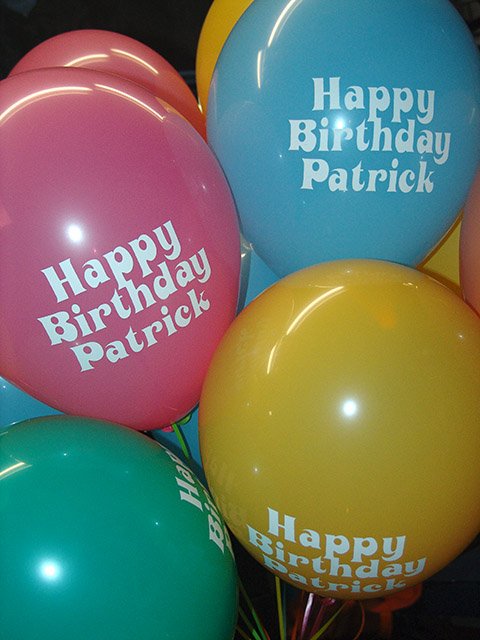Happy Birthday Balloons Biography
Source link(Google.com.pk)
Because they’re cheap and colorful, and people like watching things fly away. Balloons in their various forms were invented for use in military communications, scientific experiments, and transportation, but it wasn’t long before people began to have fun with them. The first rubber balloons were made by Michael Faraday in 1824, for use in the laboratory. Faraday laid two sheets of rubber on top of each other, put flour in the middle to prevent them from joining all the way through, and then sealed the edges together. Faraday noted that when he filled the balloons with hydrogen they had “considerable ascending power,” though he was disappointed to find that the hydrogen kept escaping. British inventor and rubber manufacturer Thomas Hancock began distributing balloon-making kits in the following year, and by 1847, London entrepreneurs were selling the first balloons made of vulcanized rubber, allowing for a stronger, more elastic balloon. It wasn’t long before the idea had been exploited for use at parties: According to an 1873 New York Times article on the balloon’s potential industrial applications, it “may be made of vast use” for meteorologists and military men “and will always be an interesting addition to the amusements of popular gatherings.”
Rubber balloons weren’t manufactured in the United States until 1907, but their popularity appears to have increased throughout most of the 20th century. The first commercial sausage balloons were produced in 1912, and Americans began twisting balloons to make animals in the late-1930s or early-1940s. Another boom in recreational balloon use occurred with the introduction of foil balloons in the 1970s. Foil balloons hold their shape better than rubber balloons, and so they were better for conveying messages like “Happy birthday!” or “It’s a boy!”
Rubber and foil balloons aren’t the only kinds used for celebrations. In East Asia, sky lanterns—a form of hot-air balloon made by lighting a small flame inside a paper lantern—have been popular for many centuries. They were initially used for military signaling, but now are launched by the hundreds as a form of celebration at many festivals. (They’re also a known fire hazard, and have been banned in some countries.) For other skyward spectacles, people have shot off fireworks and released birds.
Fears of damaging the environment have cut into balloon sales in recent years. The Balloon Council says that a properly functioning latex balloon freezes when it reaches an altitude of about five miles, breaks into slivers that look like spaghetti, and breaks down in the soil like a leaf. Indeed, natural latex is biodegradable, but most rubber balloons are made of chemical-treated latex and may last for months. Balloons can be dangerous to sea animals including porpoises, turtles, dolphins, and whales, as they can become lodged in the animal’s digestive tract (which could lead to starvation). However, the Balloon Council says that no balloon has ever been shown to be the cause of death for a sea mammal. As an alternative to releasing helium balloons, environmentalists have suggested dropping non-helium balloons from a tall building, blowing bubbles, or planting a tree
The Aztecs and Frenchies can go to war over who invented the ever beloved balloon. I recently learned Aztecs used the intestinal linings of cats to design the first resemblance of inflatables and twisted them into shapes. These were placed on altars next to foods, gifts and offerings burned in honor of the gods. Balloons have changed a lot since then, eh? Maybe you should think twice about hanging them at your child’s next birthday party (I’m glad I didn’t have them around for my 28th birthday yesterday).
Rubber balloons were crafted by a professor at the Royal Institution of London in 1824 while exploring different uses of hydrogen. Just like a fashion designer slicing patterns out from a piece of fabric, Professor Michael Faraday would cut round sheets of rubber and place the ends next to each other. By forcing hydrogen into this ‘ball’, it would expand and begin floating upward towards the ceiling. This was the first form closest to the balloon we know today.
The modern latex balloon—the kind you can blow up yourself — was invented in New England during the Great Depression over a century later. The party balloon was born (it was also used as weapon target during WWII). Superior to its rubber precedent, latex survived better in poor weather conditions. While Faraday’s experiments with hydrogen brought joy to the world of inflatables initially, we soon learned these hydrogen objects had the tendency to explode and catch on fire. Hydrogen was eventually replaced by helium, a non-flammable gas.
Balloons are objects of novelty and a fixture at parties celebrated by different cultures from all walks of life. After the party though, don’t forget these bad boys are 100% recyclable. Often confused as plastic items, balloons get lumped in again and again with the wrong kind of trash.
Latex is 100% organic, folks. It’s made from the sap of rubber trees collected through a tapping process very similar to how we collect maple sap used for producing syrup (unless otherwise noted). While we all can make the conscious effort of throwing them in the blue bin, what happens after massive public events when hundreds of balloons slowly deflate and left lifeless on the ground? Or have you ever questioned about those balloons that get accidentally released into the sky. Think you’ll see it again? Well, you won’t.
Within three hours, most latex balloons released into the atmosphere rise to approximately five miles, begin to oxidize, freeze and shatter into spaghetti-like pieces. Once these pieces hit the ground, guess what? They begin to decompose at a rate equal to or faster than an oak leaf! Yup, they are biodegradable too. Once on the ground, gases and microorganisms attack the latex, furthering the natural decomposition process – even in the dark.
Be a good steward of our earth, especially on your birthday. Remember how to dispose your balloons properly and greenly. I’m sure Faraday would appreciate it too.
Happy Birthday Balloons Happy Birthday Cake Quotes Pictures Meme Sister Funny Brother Mom to you to me Pictures

Happy Birthday Balloons Happy Birthday Cake Quotes Pictures Meme Sister Funny Brother Mom to you to me Pictures

Happy Birthday Balloons Happy Birthday Cake Quotes Pictures Meme Sister Funny Brother Mom to you to me Pictures

Happy Birthday Balloons Happy Birthday Cake Quotes Pictures Meme Sister Funny Brother Mom to you to me Pictures

Happy Birthday Balloons Happy Birthday Cake Quotes Pictures Meme Sister Funny Brother Mom to you to me Pictures

Happy Birthday Balloons Happy Birthday Cake Quotes Pictures Meme Sister Funny Brother Mom to you to me Pictures

Happy Birthday Balloons Happy Birthday Cake Quotes Pictures Meme Sister Funny Brother Mom to you to me Pictures

Happy Birthday Balloons Happy Birthday Cake Quotes Pictures Meme Sister Funny Brother Mom to you to me Pictures

Happy Birthday Balloons Happy Birthday Cake Quotes Pictures Meme Sister Funny Brother Mom to you to me Pictures
Happy Birthday Balloons Happy Birthday Cake Quotes Pictures Meme Sister Funny Brother Mom to you to me Pictures


Simple and beautiful info. I have never visited your site. This is the first time visiting I am visiting your site. If U want to know info about birthday balloons and party balloons in detail Visit
ReplyDeletehappy birthday balloons | party balloons UK